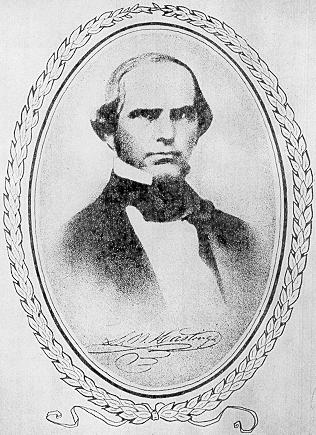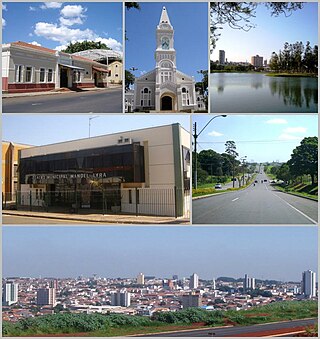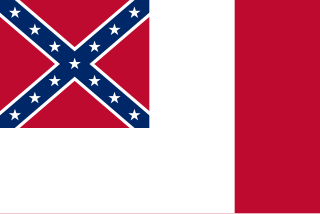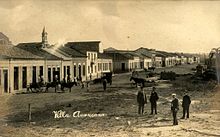
The Confederate States of America (CSA), commonly referred to as the Confederate States (C.S.), the Confederacy, or the South, was an unrecognized breakaway republic in the Southern United States that existed from February 8, 1861, to May 9, 1865. The Confederacy was composed of eleven U.S. states that declared secession and warred against the United States during the American Civil War. The states were South Carolina, Mississippi, Florida, Alabama, Georgia, Louisiana, Texas, Virginia, Arkansas, Tennessee, and North Carolina.

The Southern United States, sometimes Dixie, also referred to as the Southern States, the American South, the Southland, Dixieland, or simply the South, is a geographic and cultural region of the United States. It is between the Atlantic Ocean and the Western United States, with the Midwestern and Northeastern United States to its north and the Gulf of Mexico and Mexico to its south.

Confederados is the Brazilian name for Confederate expatriates, all white Southerners, who fled the Southern United States during Reconstruction, and their Brazilian descendants. They were enticed to Brazil by offers of cheap land from Emperor Dom Pedro II, who had hoped to gain expertise in cotton farming. The regime in Brazil had a number of features that attracted the Confederados, among these political decentralization, and a relatively high commitment to free trade. The continuing legality of slavery was another factor, though few Confederados actually acquired slaves in Brazil.

The territory of the United States and its overseas possessions has evolved over time, from the colonial era to the present day. It includes formally organized territories, proposed and failed states, unrecognized breakaway states, international and interstate purchases, cessions, and land grants, and historical military departments and administrative districts. The last section lists informal regions from American vernacular geography known by popular nicknames and linked by geographical, cultural, or economic similarities, some of which are still in use today.

Americana is a municipality (município) located in the Brazilian state of São Paulo. It is part of the Metropolitan Region of Campinas. The population is 237,240 in an area of 133.91 km2 (51.70 sq mi). The original settlement developed around the local railway station, founded in 1875, and the development of a cotton weaving factory in a nearby farm.

The history of the United States from 1849 to 1865 was dominated by the tensions that led to the American Civil War between North and South, and the bloody fighting in 1861–1865 that produced Northern victory in the war and ended slavery. At the same time industrialization and the transportation revolution changed the economics of the Northern United States and the Western United States. Heavy immigration from Western Europe shifted the center of population further to the North.

The history of the Southern United States spans back thousands of years to the first evidence of human occupation. The Paleo-Indians were the first peoples to inhabit the Americas and what would become the Southern United States. By the time Europeans arrived in the 15th century, the region was inhabited by the Mississippian people, well known for their mound-building cultures, building some of the largest cities of the Pre-Columbian United States. European history in the region would begin with the earliest days of the exploration. Spain, France, and especially England explored and claimed parts of the region.

The Knights of the Golden Circle (KGC) was a secret society founded in 1854 by American George W. L. Bickley, the objective of which was to create a new country, known as the Golden Circle, where slavery would be legal. The country would have been centered in Havana and would have consisted of the Southern United States and a "golden circle" of territories in Mexico, Central America, northern parts of South America, and Cuba, Haiti, Dominican Republic, and most other islands in the Caribbean, about 2,400 miles (3,900 km) in diameter.

The Lost Cause of the Confederacy is an American pseudohistorical and historical negationist myth that claims the cause of the Confederate States during the American Civil War was just, heroic, and not centered on slavery. First enunciated in 1866, it has continued to influence racism, gender roles, and religious attitudes in the Southern United States into the 21st century. Historians have dismantled many parts of the Lost Cause mythos.

Lansford Warren Hastings (1819–1870) was an American explorer and Confederate soldier. He is best remembered as the developer of Hastings Cutoff, a claimed shortcut to California across what is now the state of Utah, a factor in the ill-fated Donner Party of 1846. He was a Major in the Confederate States Army during the American Civil War.

Santa Bárbara d'Oeste is a municipality in the State of São Paulo in Brazil. It is part of the Metropolitan Region of Campinas. It lies about 138 kilometres (86 mi) northwest of the State capital. It occupies an area of 272.2 square kilometres (105.1 sq mi), of which 43.1 square kilometres (16.6 sq mi) is urban. In 2020, the population was estimated at 194,390 by the Brazilian Institute of Geography and Statistics, making it the 43rd most populous city in São Paulo and the sixth largest in the metropolitan region of Campinas.
Frank Lawrence Owsley was an American historian who taught at Vanderbilt University for most of his career, where he specialized in Southern history and was a member of the Southern Agrarians. He is notorious for his essay "The Irrepressible Conflict" (1930) in which he lamented the economic loss of slavery for the defeated Confederacy and of the "half savage blacks" that had been freed. He is also known for his study of Confederate diplomacy based on the idea of "King Cotton" and especially his quantitative social history of the middling "plain people" of the Old South.

American Mexicans are Mexicans of full or partial Americans heritage, who are either born in, or descended from migrants from the United States and its territories.
The Confederate Settlements in British Honduras are a cultural and ethnic sub-group in Belize, formerly known as the colony of British Honduras. They are the descendants of Confederates who fled to British Honduras with their families during and after the American Civil War.

An American Brazilian is a Brazilian person who is of full, partial or predominant American descent or a U.S.-born immigrant in Brazil.

The New Virginia Colony was a colonization plan to resettle ex-Confederates in central Mexico after the American Civil War. The largest settlement was Carlota, named for Emperor Maximilian's wife Charlotte of Belgium and located near Córdoba, Veracruz; by early 1866, it was described as "thriving" and had a population of almost 500. Other settlements were planned near Tampico, Monterrey, Cuernavaca, and Chihuahua.

New Texas was a colony established in São Paulo state, Brazil by remnants of the Confederacy after their surrender as a result of the American Civil War. The New Texas colony's manager was Frank McMullen.

Michael Hill is an American former university professor and political activist from Alabama. He is a co-founder and the president of the "Southern secession" movement the League of the South, an organization whose stated goal is to create an independent country made up of the former states of the American South.
The diplomacy of the American Civil War involved the relations of the United States and the Confederate States of America with the major world powers during the American Civil War of 1861–1865. The United States prevented other powers from recognizing the Confederacy, which counted heavily on Britain and France to enter the war on its side to maintain their supply of cotton and to weaken a growing opponent. Every nation was officially neutral throughout the war, and none formally recognized the Confederacy.
Festa dos Confederados is a festival which takes place at the end of April in Santa Barbara, d'Oeste in the state of São Paulo, Brazil. The festival commemorates the history of the Confederados, who were a group of Confederate soldiers fleeing to Brazil to continue practicing slavery after the defeat of the Confederate States of America following the American Civil War, as Brazil was one of the last countries to legally bar slavery. As years have passed, there has been an increase in contention around the holiday as Americans see the symbol of the Confederate flag as a symbol of historical racism, and Brazilian Confederados see it as something that connects them to their ancestors.















